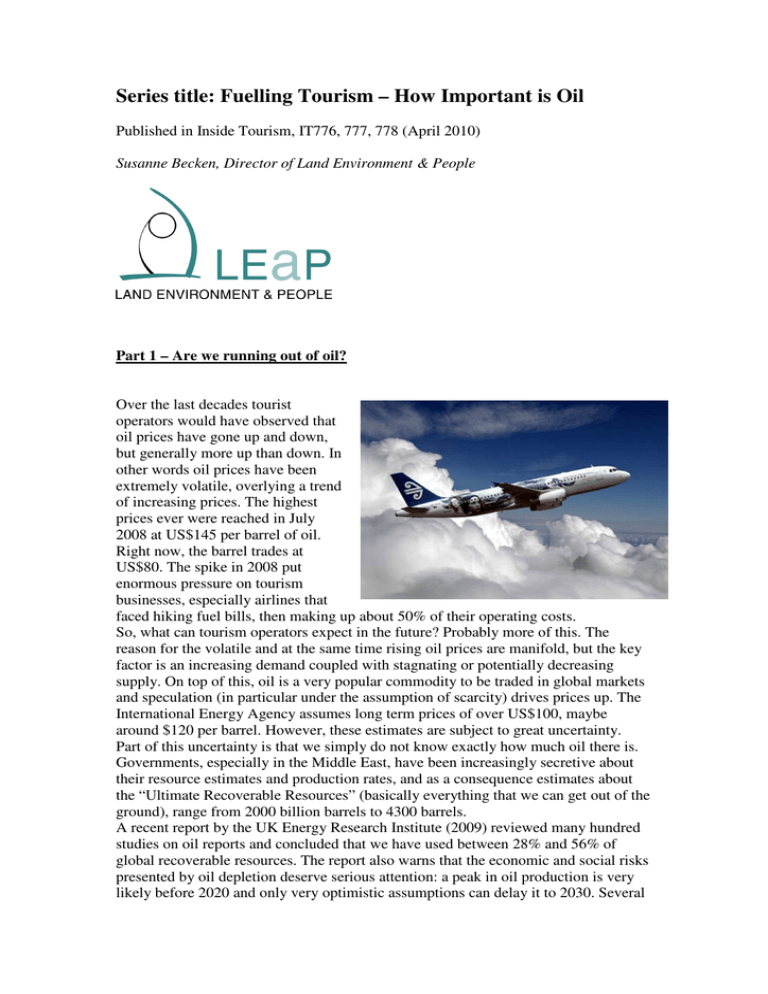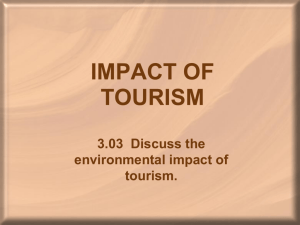Series title: Fuelling Tourism – How Important is Oil
advertisement

Series title: Fuelling Tourism – How Important is Oil Published in Inside Tourism, IT776, 777, 778 (April 2010) Susanne Becken, Director of Land Environment & People Part 1 – Are we running out of oil? Over the last decades tourist operators would have observed that oil prices have gone up and down, but generally more up than down. In other words oil prices have been extremely volatile, overlying a trend of increasing prices. The highest prices ever were reached in July 2008 at US$145 per barrel of oil. Right now, the barrel trades at US$80. The spike in 2008 put enormous pressure on tourism businesses, especially airlines that faced hiking fuel bills, then making up about 50% of their operating costs. So, what can tourism operators expect in the future? Probably more of this. The reason for the volatile and at the same time rising oil prices are manifold, but the key factor is an increasing demand coupled with stagnating or potentially decreasing supply. On top of this, oil is a very popular commodity to be traded in global markets and speculation (in particular under the assumption of scarcity) drives prices up. The International Energy Agency assumes long term prices of over US$100, maybe around $120 per barrel. However, these estimates are subject to great uncertainty. Part of this uncertainty is that we simply do not know exactly how much oil there is. Governments, especially in the Middle East, have been increasingly secretive about their resource estimates and production rates, and as a consequence estimates about the “Ultimate Recoverable Resources” (basically everything that we can get out of the ground), range from 2000 billion barrels to 4300 barrels. A recent report by the UK Energy Research Institute (2009) reviewed many hundred studies on oil reports and concluded that we have used between 28% and 56% of global recoverable resources. The report also warns that the economic and social risks presented by oil depletion deserve serious attention: a peak in oil production is very likely before 2020 and only very optimistic assumptions can delay it to 2030. Several factors are important in addition to how much oil there is, including the level of demand (the global recession was a breather) in the next few years, the natural decline rates of oil fields, and the time in which new investments to recover oil can be made. Access to unconventional oil sources such as Canadian tar sands may help to ‘flaten’ the peak but are unlikely to change the big picture of decline. Saudi Arabia is the single most important player in the fate of global oil. It has acted as a ‘swing’ state for many decades, however, there is increasing concern about the reaching of maturity of Saudi’s oil fields which would then almost definitely result in a global decline in production. Intense exploration efforts in many parts of the world, including New Zealand, are drops in the bucket compared with Saudi Arabia’s super giant oil fields and, while making an economic difference to these individual countries, these will not suffice to meet growing demand. The more stretched the global oil market in terms of just meeting demand the more vulnerable it is to any disturbance, for example political issues, technical problems, and accidents. In a market at capacity, all of these will have severe repercussions resulting from temporary shortfalls and price hikes. For these reasons operators are safe to assume that not only will oil prices go up in the near and long term, but also they will be riddled by marked ups and downs that will make business planning challenging. Tourism, as a relatively energy intensive sector, could potentially be significantly affected by global oil prices. Research into these effects will be reported on next week (Part 2), followed by a discussion on what the sector can do to reduce its vulnerability in Part 3 of this series. Oil exploration in the United States. Part 2 – How vulnerable is NZ tourism to oil price shocks In the medium term, oil prices are likely to increase – but what does this mean for the tourism industry? Not everyone will be affected in the same way. A key question relates to how tourists might change their demand for travel. Tourists from oilimporting countries (many of NZ’s current visitors) are more vulnerable than those from oil exporting countries (e.g. Middle East but also Canada and Norway), at least in the short term. Developing countries such as China will also be more affected than mature economies such as Germany. Research shows that the biggest effect of oil price increases will be at a macro economic level. Slowing economies will the affect tourism demand because of lower incomes and less discretionary spending power. Lower incomes lead to less travel, reduced expenditure and a shift to short haul from long haul travel. These effects are exacerbated by higher costs of travel, in particular aviation but also other components of tourism. Our research into the price sensitivity of tourists to New Zealand indicates that the Asian markets react most sensitively to price changes and visitors from the USA the least. Interestingly, our neighbours from across the Tasman appear very responsive to the price of airfares (not so much to prices within NZ): low airfares in the past always boosted numbers from Australia and high airfares resulted in reduced volumes. Tourists (across all origins) that respond quite clearly to higher prices are typically holiday tourists. These are about 48% of NZ visitors. Those coming for business or visiting friends or relatives are less sensitive to price changes. In 2008, petrol prices in New Zealand reached an all time high and the sales of automotive fuels decreased substantially. The question arises whether tourists, once in New Zealand, are likely to adjust their travel itineraries to economise on fuel. If yes, then this would have major implications for businesses that are located in more remote destinations or away from the main tourist trunks. Our research does not support this hypothesis. The relationship between transport decisions and fuel prices, at least as observed in the last 10 years, is minimal and tourists seem unlikely to drastically change their travel patterns. The research also shows that tourists have different perceptions of fuel prices, as these are always relative to what they experience in their own country. American tourists, for example, consider fuel to be very expensive whereas European tourists find it very cheap. While there are some kinds of tourism businesses that are inherently more vulnerable than others – mainly due to their fuel intensity – we found that it is not possible to draw generic conclusions about who is at risk from high oil prices and who is not. Rather, we identified a portfolio of ‘risk factors’, including the operator’s energy profile and their customer mix. Energy costs – especially those relating to fossil fuels – can pose a Scenic glacier flights, West Coast NZ major constraint on business profitability and substitutions or improvements in efficiency may alleviate this risk at least in the long term. However, probably even more important is the markets that a particular business deals with. Here, both the numbers (i.e. how many would still come in a world of high oil prices) and their specific price sensitivity are important factors. Finally, in the long term, geographic location might have some bearing on whether tourists chose to visit or not. In the final part of this series, Part 3, we will discuss in more detail what is being done and what can be done to prepare the tourism sector for higher oil prices and minimise unfavourable surprises. Bus driver filling up the coach in Omarama, New Zealand. Part 3 – What are we doing to prepare for oil shocks? In Parts 1 and 2 I discussed how oil prices are likely to increase and how this might affect tourism to and within New Zealand. The question now is what is being done to prepare for these changes and reduce vulnerability to higher oil prices. One major challenge is that (peak) oil is – just like climate change – seen to be a longer term issue that goes beyond the immediate concerns of a tourism business. Governments may think in time spans of three to four years and businesses are (understandably) concerned about even shorter time frames and their associated developments. As discussed in my earlier articles, oil prices will require attention in the longer term future, but as history has shown (and unlike climate change), they may equally strike in the very short term. In fact, increased volatility is one of the characteristics predicted by many energy experts. What is New Zealand tourism doing about this? Responses fall into two major categories: one relates to national-level responses and the other one deals with what individual tourism businesses can do. At a higher level, the government has started to become increasingly strategic in their tourism investment. For example, macroeconomic considerations such as which country earns how much GDP are increasingly important in the allocation of marketing dollars and other strategic decisions, for example air links. Markets of growth are identified and balanced with factors of risk. Environmental perceptions, vulnerability to oil prices, sensitivity to other shocks (e.g. a pandemic) are taken into consideration. Further, new markets, such as those in the Middle East (building on the already successful education market), are now explored and information on oil vulnerability and tourists’ price sensitivity is integrated into these processes. At a business level there are a range of initiatives that can reduce a businesses’ vulnerability to oil prices. One is to think strategically about what markets the business depends on and how these would respond to oil shocks (and other risk factors). A diversified market portfolio in itself reduces risk compared with an operator that solely depends on one market. Important questions include: where do my customers come from, how price sensitive are they and how does my business compare with potential competitors. Product diversification is another strategy to divert risk. For example, a mix of energy-intensive (e.g. scenic flights) with energyextensive (e.g. guided walk) activities would allow a business to divert resources toward those parts of their product portfolio that are less exposed to oil prices. This may be challenging when large amounts of capital are involved; however, in the long run a business might benefit from reducing its oil dependency be reducing energy consumption where possible. The recently undertaken energy audits as part of the Tourism Industry Association TEEP project give a very good indication of the potentials for energy reduction in tourism businesses. An analysis of the audits indicates that there is a wide range of measures that can be implemented with minimal investment and very quick pay-back times. Some energy saving or fuel switching measures have longer pay back times, for example in the order of 10 years for double glazing or solar hot water systems. However, tourism operators who explicitly consider higher oil prices in their calculations may find that pay back times could decrease dramatically. A range of schemes are available that support tourism businesses in their efforts to reduce energy bills. Some developments, for example in the transport area (e.g. biofuels, electric vehicles etc) are beyond the immediate control of a tourism business, and they are not readily available. However, tourism operators and the sector as a whole may exert some influence on the nature of such technological changes by keeping involved, lobbying and supporting government agencies in their attempts to reduce fossil fuel consumption in New Zealand beyond the tourism sector. Reducing the need for costly, imported oil will not only reduce vulnerability to price hikes, but also reduce long term business costs, and underpin New Zealand’s green image by reducing carbon emissions. Electric mini vehicles in a European tourist resort (Photo: Dan Scott)




